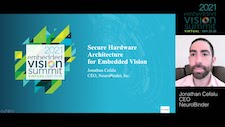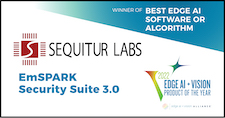|
IoT and Vision: Why It’s a Security Minefield and How to Navigate It
Recent advancements in machine learning have enabled market innovators to build insights from IoT sensors in the wild. These insights can be used to solve complex real-world challenges. The lack of security in typical vision-based IoT solutions is especially concerning, as they are typically responsible for managing sensitive data (PID, CCTV) or critical systems (cars, machinery). Security is rarely the first thought for developers of new types of solutions, but making systems secure after the fact is difficult since a holistic approach is required. Exacerbating this challenge of achieving end-to-end security, the development and deployment of IoT systems often involves multiple handovers of responsibility, which can make achieving end-to-end security difficult. And, due to the complexity and diversity of these systems, security bodies have been unable to prescribe “silver bullet” solutions. Based on first-hand experience, this 2021 Embedded Vision Summit presentation from Dr. Lyndon Fawcett, Principal Software Security Architect at Arm, provides insights to help decision-makers better understand key challenges and potential solutions for providing secure vision-based IoT systems.
A Secure Hardware Architecture for Embedded Vision
Security is a problem for every IoT system, but due to privacy concerns, security is particularly worrisome for embedded vision systems. In this talk from the 2021 Embedded Vision Summit, Jonathan Cefalu, CEO and founder of NeuroBinder, covers how to design your embedded device so that the hardware architecture itself enforces strict guarantees about where visual data is able to flow. In particular, Cefalu explores the idea of a “data diode” that uses hardware to enforce what parts of the system have access to video or images. This provides the highest level of protection against hacking or malware, as even if the device is completely hacked at the root level, the intruder will still be unable to access the visual data.
|
|
A New Adaptive Module for Vision AI at the Edge
Kria System-on-Modules (SOMs), as described by Chetan Khona, Director of the Industrial, Vision, Healthcare and Science Markets at Xilinx (now part of AMD) in this 2021 Embedded Vision Summit presentation, provide a secure, production-ready multi-core Arm and FPGA platform, including memories, power management, and Yocto or Ubuntu Linux to build accelerated AI-enabled applications at the edge. Kria SOMs enable smart vision applications across cities, factories, and hospitals to achieve high performance with low latency, low power consumption and a small footprint. And Kria SOMs feature a radical new way to design with Accelerated Applications via the App Store. Kria Accelerated Apps offer an industry-first: they enable both new and experienced designers to skip doing any FPGA design. Accelerated Apps give the SOM the personality of a purpose-built smart camera, AI box, or other vision AI system. Apps are fully accelerated—including image acquisition, pre-processing, AI inference, post-processing, encoding and connectivity—offering the highest performance for industrial use cases. Accelerated Apps span license plate recognition, retail shopper re-identification, HDR image signal processing, natural language processing and more.
An Introduction to Single-Photon Avalanche Diodes—A New Type of Imager for Computer Vision
The single-photon avalanche diode (SPAD) is an emerging image sensing technology with unique capabilities relevant to computer vision applications. Originally designed for imaging in low-light conditions, the ultra-high time resolution of SPADs also helps to achieve extremely high dynamic range, motion blur-free images and even seeing around corners. The use of SPADs in recent iPhone models has spurred increased interest in the use of SPADs in commercial products. In this talk from the 2021 Embedded Vision Summit, Sebastian Bauer, Postdoctoral Student at the University of Wisconsin – Madison, introduces SPAD-based imagers, explains how they work, presents their fundamental capabilities, and identifies their key strengths and weaknesses relative to conventional image sensors. He also shows how they can be used in a variety of applications.
|
|
Sequitur Labs EmSPARK Security Suite 3.0 (Best Edge AI Software or Algorithm)
Sequitur Labs’ EmSPARK Security Suite 3.0 is the 2022 Edge AI and Vision Product of the Year Award winner in the Edge AI Software and Algorithms category. The EmSPARK Security Suite is a software solution that makes it easy for IoT and edge device vendors to develop, manufacture, and maintain secure and trustworthy products. By implementing the EmSPARK Security suite, enabled by industry-leading processors, device OEMs can: isolate and protect security credentials to prevent device compromise, protect critical IP, including device-resident software, prevent supply chain compromises with secure software provisioning and updates and accelerate time-to-market while reducing implementation cost and overall security risk. The EmSPARK Security Suite is the industry’s first solution to provide a suite of tools for protecting AI models at the Edge. With the release of EmSPARK 3.0, developers can safely deploy AI models on IoT devices, opening the door for a new era of edge computing.
Please see here for more information on Sequitur Labs’ EmSPARK Security Suite 3.0. The Edge AI and Vision Product of the Year Awards celebrate the innovation of the industry’s leading companies that are developing and enabling the next generation of edge AI and computer vision products. Winning a Product of the Year award recognizes a company’s leadership in edge AI and computer vision as evaluated by independent industry experts. |







